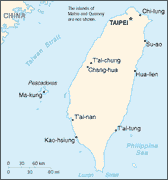National Energy Grid
|
 |
|
Full Size Map National Electricity Transmission Grid of Taiwan(10 kb) |
GRID SUMMARY
Oil is by far the dominant fuel in Taiwan's energy mix, accounting for 51% of total primary energy consumption. Coal also plays an important role (32% of total energy consumption), followed by nuclear power (8%), natural gas (6%), and hydroelectric power (2%). Taiwan has very limited domestic energy resources and relies on imports for most of its energy requirements. The country's industrial sector accounts for more than half of total energy demand, but this share is expected to decline slightly, since Taiwan's economy is moving toward newer, less energy-intensive industries. The transportation sector accounts for one-quarter of total energy demand.
One major controversy which has affected Taiwan's electric power over the past two years concerns the future role of nuclear power. Taiwan's Democratic Progressive Party government came into office in early 2000 promising to approve only LNG-fired power projects in the future, and to increase LNG's share of Taiwan's power generation to roughly one-third by 2010. This raised the question of what to do about the 2,700-MW Kungliao nuclear power plant, which is currently under construction. The DPP government attempted to terminate the project in October 2000, but action by the legislature and courts forced a resumption of construction in February 2001. The plant currently is scheduled to begin operation in July 2006. After that, the current government does not plan to support additional nuclear generating capacity. Some officials have reportedly started to question the designation of LNG as the "fuel of choice" for electricity generation, due to costs, which might mean the approval of additional coal-fired capacity for incremental demand after the completion of the Kungliao and Tatan projects in 2006.
A new electricity law has been under consideration in Taiwan's parliament, the major feature of which is expected to be the privatization of Taipower. Progress, though, has been slow, and the legislation is being reworked by the new Democratic Progressive Party government which came into office in May 2000. Under the basic framework envisioned, Taipower would retain a monopoly on transmission and distribution networks, but Taipower's generation assets would be split into several firms. The planned privatization is to an extent the result of rapidly rising power demand in Taiwan, and Taipower's inability to build sufficient capacity to keep pace with demand, which led to a power crisis during the summer peak-demand months in 1999. The expected date for completion of Taipower's privatization was originally 2001, but several issues, most notably the controversy over nuclear power, have pushed the expected date back to 2006.
ENERGY SUMMARY : TAIWAN
Map
of Taiwanese Electricity Grid | National Energy Grid Index
GENI Home Page | Contact
GENI | Subscribe
to GENI Newsletter | Pledge
| Comments
| GENI Forum
Email this page to a friend
If you speak another language fluently and you liked this page, make
a contribution by translating
it! For additional translations check out FreeTranslation.com
(Voor vertaling van Engels tot Nederlands)
(For oversettelse fra Engelsk til Norsk)
(Для дополнительных
переводов проверяют
FreeTranslation.com )

